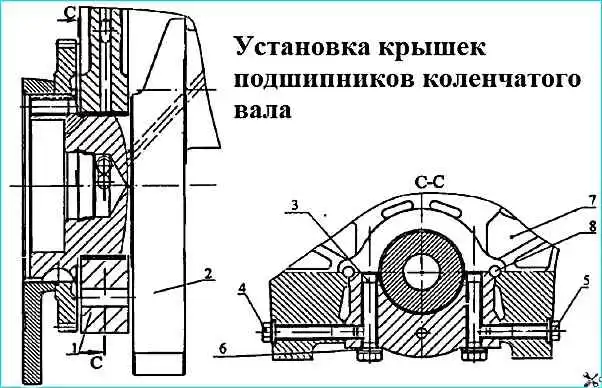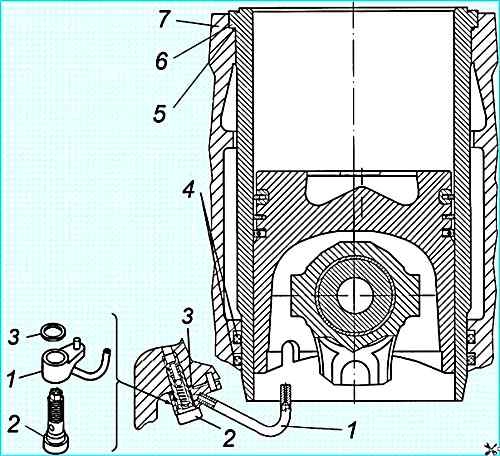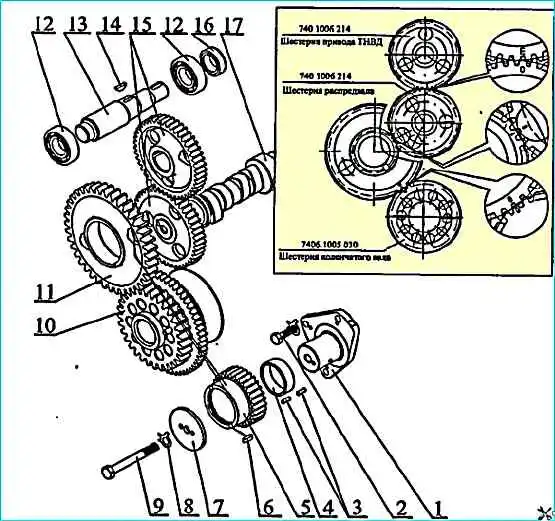The engine cylinder block is cast from cast iron
The casting is subjected to artificial aging to relieve thermal stress, which allows the block to retain the correct geometric shapes and dimensions during operation.
Two rows of half-blocks for cylinder liners, cast as a single piece with the upper part of the crankcase, are located at an angle of 90° to each other.
The left row of bores for the liners is offset relative to the right forward (towards the fan) by 29.5 mm, which is due to the installation of two connecting rods on each crankpin of the crankshaft.
Each bore has two coaxial cylindrical holes made in the upper and lower belts of the block, along which the cylinder liners are centered, and undercuts in the upper belt, forming annular platforms for the flanges of the liners.

Installing the crankshaft bearing caps: 1 - bearing cap; 2 - crankshaft; 3 - cap mounting bolt; 4 - left bearing cap tie bolt; 5 - right bearing cap tie bolt; 6 - washer; 7 - block; 8 - pin
To ensure correct fit of the liner in the block, the parameters of flatness and perpendicularity of the thrust pad under the liner flange relative to the axis of the centering bores are performed with high accuracy.
Two grooves for sealing rings are made on the lower belt, which prevent coolant from entering the cooling cavity of the block into the cavity of the engine oil sump.
The bosses of the holes for the cylinder head mounting bolts are made in the form of lugs to the transverse walls that form the cooling jacket, evenly distributed around each cylinder.
The crankcase part of the block is connected to the main bearing caps with main and tie bolts.
The centering of the main bearing caps is performed by horizontal pins 8 (Figure 1), which are pressed into the joint between the block and the caps, but mostly included in the block to prevent their loss when removing the covers.
In addition, the cover of the fifth main support is centered in the longitudinal direction by two vertical pins, ensuring the accuracy of the coincidence of the bores for the crankshaft thrust half rings on the block and on the covers.
The order of tightening the bolts for fastening the covers of the main supports in accordance with the article - "Tightening torques of diesel connections"
The cylinder block is bored for the main bearing shells assembled with the covers, therefore the main bearing covers are not interchangeable and are installed in a strictly defined position
Each cover has a serial number for the support, the numbering of which starts from the front end of the block.
In the crankcase part of the collapse of the cylinder block, the valve tappet guides are made in the form of bosses
Closer to the rear end between the fourth and eighth cylinders, to improve circulation of the coolant, a bypass pipe of the cooling cavity is made.
At the same time, it also gives the block additional rigidity
Parallel to the axis of the bores for the crankshaft bearings, bores for the camshaft bushings of increased size are made.
The diameters of the oil channels in the cylinder block are increased.
At the bottom of the cylinders, together with the block, bosses for the piston cooling nozzles are cast.
In order to install a filter with a heat exchanger on the right side, the area under the filter is increased, compared to the 740.10 engine, two additional mounting holes and a drain hole from the filter are introduced.

Cylinder liner with piston cooling nozzle: 1 - nozzle tube; 2 - piston cooling nozzle valve assembly; 3 - sealing gasket; 4 - lower liner sealing ring; 5 - upper sealing ring; 6 - cylinder liner; 7 - crankcase
Cylinder liners (Figure 2) "wet" type, easily removable have marking 740.50-1002021 on the conical part at the bottom of the liner.
Installation of liners with other markings is not allowed due to the resulting contact with the connecting rod.
The 740.50-360 and 740.51-320 engine liners are 3 mm lower in height than the liners of other KAMAZ engine models with dimensions 120x120.
The cylinder liner is made of special gray cast iron strengthened by volume quenching.
At the liner - cylinder block connection, the cooling cavity is sealed with round rubber rings sections.
A ring 5 is installed in the upper part in the groove of the sleeve, in the lower part - two rings 4 in the bore of the cylinder block.
The microrelief on the mirror of the sleeve is a rare grid of depressions and platforms with small risks at an angle to the axis of the liner.
When the engine is running, the oil is retained in the depressions, which improves the running-in of the cylinder-piston group parts.
During engine assembly, the cylinder number and piston version index are applied to the non-working projection of the liner end face.

Drive units: 1 - axis of the leading gear of the camshaft drive; 2 - axle mounting bolt; 3 - rollers 5.5x15.8 in the amount of 62 pcs.; 4 - intermediate roller sleeve; 5 - driving gear; 6 - key; 7 - thrust washer; 8 - lock washer; 9 - bolt M12x1.25x90 for fastening bulk bearing; 10 - crankshaft drive gear; 11 - intermediate gear; 12 - ball bearings; 13 - fuel injection pump drive wheel shaft; 14 - key; 15 - fuel injection pump drive gear; 16 - sleeve; 17 - camshaft assembly with gear
The drive of the units (Figure 3) is carried out by spur gears and serves to drive the valve timing mechanism, high-pressure fuel pump, compressor and power steering pump of the car.
The valve timing mechanism is driven by gear 10 mounted on the crankshaft tailstock, through a block of intermediate gears that rotate on two rows of rollers 3 separated by an intermediate sleeve 4 and located on an axis 1 fixed to the rear end of the cylinder block.
A gear is pressed onto the end of the camshaft, the angular position of which relative to the shaft cams is determined by a key.
Gear 15 of the high-pressure fuel pump (HPFP) drive is mounted on shaft 13 of the HPFP drive and is fixed with key 14.
The gears are installed on the engine in a strictly defined position according to the mark "0" on the camshaft drive gear, the mark "E" on the fuel injection pump drive gear and the risks stamped on the gear wheels, as shown in Figure 7.
The fuel injection pump is driven by gear 15, which is in engagement with the camshaft gear.
Rotation from the shaft to the fuel injection pump is transmitted through the leading and driven half couplings with elastic plates that compensate for the misalignment of the fuel injection pump shafts and gears
The compressor and power steering pump drive gears are in engagement with the fuel injection pump drive gear.
The crankcase of the units is attached to the rear end of the cylinder block.
There are bores in the upper part of the crankcase of the units, in which the compressor and power steering pump are installed.
On the sides of the unit housing there are bosses with holes for draining oil from the turbochargers and a hole for the oil level indicator.
The unit drive is closed by the flywheel housing, secured to the rear end of the cylinder block through the unit housing.
On the flywheel housing on the right there is a place for installing the flywheel lock, used to set the fuel injection advance angle and adjust the thermal clearances in the valve timing mechanism.
The lock handle must be in the upper position when the engine is running.
It is moved to the lower position during adjustment work, in which case the lock is engaged with the flywheel.
A bore is made in the upper part of the flywheel housing, into which the rear bearing housing is installed.
Below in the left The crankcase has a bore in which the starter is installed. In the middle of the crankcase, a bore is made for the crankshaft seal.
A lug is made in the upper part of the crankcase on the left, designed for installing the power take-off (PTO). In the absence of a PTO, the inner surfaces of the lug are not processed.
The rear flange of the flywheel housing is made with connection dimensions according to SAE1.





